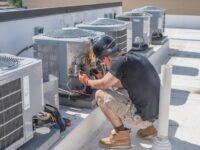DIY Guide to Metal Roof Leak Repair – Sealant Products and Techniques

Meta: What are the best metal roof leak repair products and what techniques can you use to get your roof back into working order fast? Here’s what you need to know.
Keywords: metal roof leak repair
Are you having problems with metal roof leaks? Don’t worry, it’s a common problem faced by many homeowners. If you’re looking for a DIY guide to metal roof leak repair, you’ve come to the right place! This guide will provide you with the necessary information about sealant products and techniques to help you fix your roof leaks.
Overview of Metal Roof Leak Repair
While the lifespan of a metal roof is around 50 years, many homeowners start noticing roof leaks 10 to 15 years into their roof’s life. Metal roof leaks occur when there is a crack in the roof’s surface that allows water to seep through and accumulate on the roof’s surface, causing damage to the roof’s shingles and the underlying surface.
Metal roof leak repair is necessary to prevent water from seeping into your home and causing damage to your interior. If you spot any signs of a metal roof leak, such as discoloration of the shingles or a wet surface, it’s best to address it as soon as possible. Depending on the size and severity of the leak, you may want to consult a professional roofer before attempting metal roof leak repair.
Types of Sealants Available
There are many different sealant products available on the market. The most cost effective and easiest to use for DIYers are polyurethane sealants (liquid rubber). While all of these sealants are effective at stopping roof leaks, it’s important to choose the right sealant for your roof to get the best results.
How to Apply the Sealant Effectively
You can’t just slap on a dab of sealant and expect it to do its job. The key to applying sealant effectively is to use the right technique and have the right tools on hand to do the job properly.
Follow these tips to apply sealant effectively:
- You’ll want to thoroughly clean the area where you plan to apply the sealant. A dirty surface will prevent the sealant from adhering properly and may contaminate the product. –
- Sealants come in different thicknesses: solvent-based sealants are thick, while water-based sealants are thinner. You’ll want to use a sealant that’s of the right thickness to ensure that it adheres properly to the surface. Using a sealant that’s too thick may cause it to form a crust on the surface that will prevent water from escaping.
- You want to apply sealant in multiple layers; a single coat is not enough. Expect to layer coats in between drying and curing — with 3-4 heavy coats being ideal.
- You don’t want to get sealant on your hands, your clothes, or your face. Make sure to wear gloves and a respirator when applying sealant to avoid getting it on your skin.
- Don’t expect your sealant to immediately cure. It may take up to 24 hours for the sealant to fully cure and adhere to the surface.
Conclusion
Metal roof leaks generally occur as a result of aging or improper installation. The best way to prevent metal roof leaks is to regularly maintain your roof and clean the roof regularly. Roof leaks can be a big problem, but they are easily preventable.
By following the tips and recommendations in this guide, you can easily prevent metal roof leaks and keep your home safe and dry. With the right sealant, you can easily take control of your metal roof leak repair and get your roof back in shape in no time.
Need Even More Tips on DIY Home Improvement?
We’re here to help you by providing tips for all of your home improvement DIY project needs. Take a look at a few related guides we’ve published to see what other projects we can help you get done faster. Read More Articles About Liquid Rubber.





